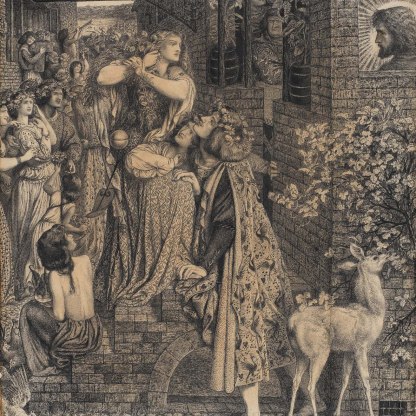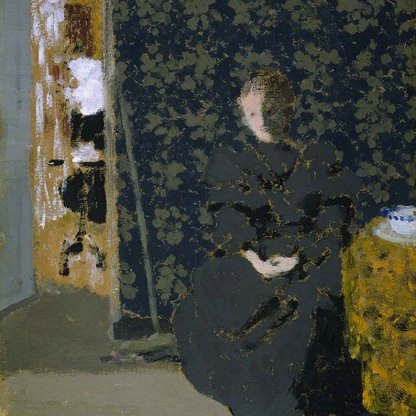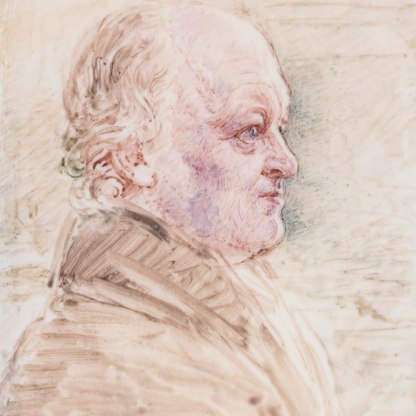The Pre-Raphaelite Brotherhood
- to have genuine ideas to express
- to study nature attentively, so as to know how to express them
- to sympathise with what is direct and serious and heartfelt in previous art, to the exclusion of what is conventional and self-parading and learned by rote
- and most indispensable of all to produce thoroughly good pictures and statues.
This is the original statement of intent formulated by the Pre-Raphaelite Brotherhood at its foundation in September 1848. The Brotherhood was formally inaugurated at the home of one of its leading members, John Everett Millais, at 83 Gower Street in London, just around the corner from the British Museum. There were seven members, of which the most important were Millais, William Holman Hunt and Dante Gabriel Rossetti. The painters James Collinson and F.G. Stephens were also enrolled along with the sculptor Thomas Woolner. Dante Gabriel’s brother William Rossetti, then a clerk with the Inland Revenue, was appointed as secretary to the group. He also edited their magazine, The Germ, which first appeared in 1850 and ran for four issues.
They were energetic, idealistic young men, spurred on by shared disillusionment at the state of contemporary British art, which they considered – with some justification – to be stuck in an Academic rut. They wished to return to a simplicity and honesty characterised for them by the early Italian painters who came before Raphael (1483–1520). They aimed to restore religious art to an elevated position and sought new ways of showing the traditional Christian subjects. They also drew inspiration from literary works – Shakespeare, Dante, Chaucer – and strove for a brighter-coloured, more morally informed art, based upon truthful observation of nature while at the same time being richly symbolic. In appearance and content, the early Pre-Raphaelite works strongly reflect the art of the middle ages.
The first important paintings by Rossetti, Millais and Hunt were exhibited in 1849, each bearing the letters PRB, the initials of their recently formed organisation. These early works attracted immediate and hostile criticism. Their style was derided as crude, and the Pre-Raphaelite title was considered an arrogant affront to their predecessors of the last 350 years. Moreover, the Italian ring to their name drew accusations of sympathy with the Roman Catholic Church.
In 1851, however, they found an influential supporter in the artist and critic John Ruskin. After a painting by Millais, Christ in the House of his Parents ('The Carpenter’s Shop'), now in Tate Britain, drew particularly hostile comment, Ruskin wrote a letter to The Times, justifying the subject-matter and its highly original treatment. The Pre-Raphaelites practised the kind of precise observation of nature that Ruskin had been promoting in his written work for several years, and he wrote in their defence that they might 'lay in our England the foundation of a school of Art nobler than the world has seen for three hundred years'.
But by the early 1850s, the original members of the Brotherhood had already begun to go their separate ways. Rossetti ceased to exhibit his works publicly after his Annunciation, now in Tate Britain, was savaged by the critics in 1850. Millais, who had been the youngest ever pupil admitted to the Royal Academy at the age of eleven, was voted an associate of the Academy, and gradually drifted towards the mainstream. In 1852 Woolner the sculptor emigrated to Australia, and in 1854 the increasingly religious Hunt set off on a tour of the Holy Land.
Ford Maddox Brown, an older artist, was never formally a member of the Brotherhood but was sympathetic to many of their ideals. He was particularly influential upon Rossetti. It is said that Rossetti once sent him a fan letter that was so gushing in its praise that the recipient thought he was being ridiculed. Grabbing a stick, he hurried to the address on the letter with the intention of thrashing the insolent young author. Rossetti’s natural charm calmed him down however, and a close, if sometimes fraught, professional relationship developed.
Edward Burne-Jones and William Morris had discovered the Pre-Raphaelites whilst undergraduates at Oxford and both became friendly with Rossetti during the second phase of Pre-Raphaelitism. Burne-Jones' detailed, often brightly coloured, poetically inspired paintings in particular owe much to the early works of the PRB.
Other highlight objects you might like
Other pathways and stories you might like
Sign up to our emails
Be the first to hear about our news, exhibitions, events and more…





